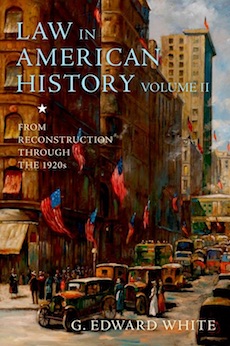By Allen D. Boyer
G. Edward White, who has written distinguished studies of John Marshall’s Supreme Court and Oliver Wendell Holmes, has reached the second, crucial phase of his history of American law. This is the point, beginning with the close of the Civil War, when the growth of the republic handed to American judges a new and overawing brief: to routinely dispense justice on matters of racial equality, nationwide commerce, government regulation, workers’ rights, immigration, and free speech – as well as torts and contracts, old areas of law which had been freshly re-imagined.
White opens by reviewing the transformation that was wrought upon American law, but the heart of this book is his study of how the judges ruled, and how they made the decisions. For the judges of this era seemed unwaveringly hostile to the changes that were emerging. They ignored racial injustices, preferred corporations and employers to unions and employees, let immigrants be summarily deported, and gave the government a fairly free hand to jail political radicals for sedition.
The conservative legal regime of this era has been pilloried by scholars for more than a century. One memorable battle cry was Justice Holmes’ sarcastic remark that the majority decision in Lochner v. New York (1905) “was decided upon an economic theory which a large portion of the country does not entertain,” the Social Darwinism of “Mr. Herbert Spencer’s Social Statics.” Equally memorable was the epithet of “Nine Old Men,” hurled at the Supreme Court when it struck down New Deal legislation.
Without absolving the judges for their failures of vision, White argues that they were not ideologues. Rather, he argues, they adopted the policy of “guardian review.” They followed the traditional policy of the Marshall Court, which had claimed authority to rule on legal issues while leaving political decisions to other branches of government.
There was new law to rule on, White observes: the Fourteenth Amendment suggested that the Constitution protected liberties, privileges, and immunities against state action, and the courts came to pack these terms with substance – which meant, striking down regulation in areas where states had not traditionally regulated. (States clearly possessed the “police power” to protect health, safety, and morals; they were on treacherous ground when they reached out to support labor unions.) The judges saw themselves as making no laws and establishing no policy. They saw their role (as one justice put it) as “limited to seeing that popular action does not trespass upon right and justice as it exists in written constitutions and natural law.”
On matters of race and politics, the judges continued to defer to other branches of government. “Neither the Equal Protection Clause, the First Amendment, nor the Due Process Clauses of the Fifth and Fourteenth Amendments were understood as significantly curtailing the decisions of other branches that made classifications based on race or restricted categories of expression. The mainstream jurisprudence of race relations and of free speech . . . was neither solicitous of the position of racial minorities nor vigilant to defend the constitutional rights of unpopular speakers. In those respects that jurisprudence reflected the attitudes of a majority of late nineteenth- and early twentieth-century Americans.”
The judges were not ideologues and partisans, but they unwittingly conformed to the wisdom of their age.
White finds that the Supreme Court’s decision-making practices contributed to its self-satisfaction. Opinions were researched and drafted by individual justices, without the circulation of draft opinions; they were endorsed or acquiesced in by their authors’ brethren, usually without revision; dissents were discouraged. This process tended to confirm the idea that law was a matter found by the judges and affirmed by an exercise of their common professional wisdom, rather than an assertion of judicial power.
White draws a lesson from this history: that courts’ work routine reflects the judicial process, eternally and inevitably. He makes a trenchant point:
“A generalization can be hazarded . . . The Supreme Court’s internal deliberative practices are invariably a signal of the foundational jurisprudential assumptions shared by its members; those practices and assumptions are self-reinforcing; and when the Court’s internal practices gradually or suddenly change, assumptions about the nature of law in America and the function of Supreme Court judges are likely to be in flux.”
In the modern era, every Supreme Court decision seems to arrive as a spectrum of individual opinions. Justices debate each other in draft opinions and dissents. They are fêted for their partisan spirit. That process reflects its own foundational jurisprudential assumption, that law is politics – a perspective that may misguide judges just as badly as the assumption that law is apolitical. We can ask more from our judges than the mere wisdom of our own divided age.
Allen D. Boyer (ΦBK, Vanderbilt University, 1977) is a lawyer and writer in New York City. His fifth book, “Rocky Boyer’s War,” has recently been published by the Naval Institute Press. Vanderbilt University is home to the Alpha of Tennessee Chapter of Phi Beta Kappa.




